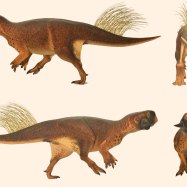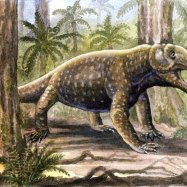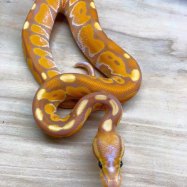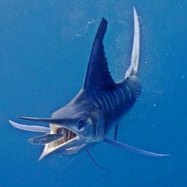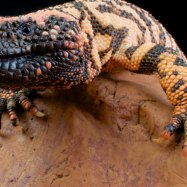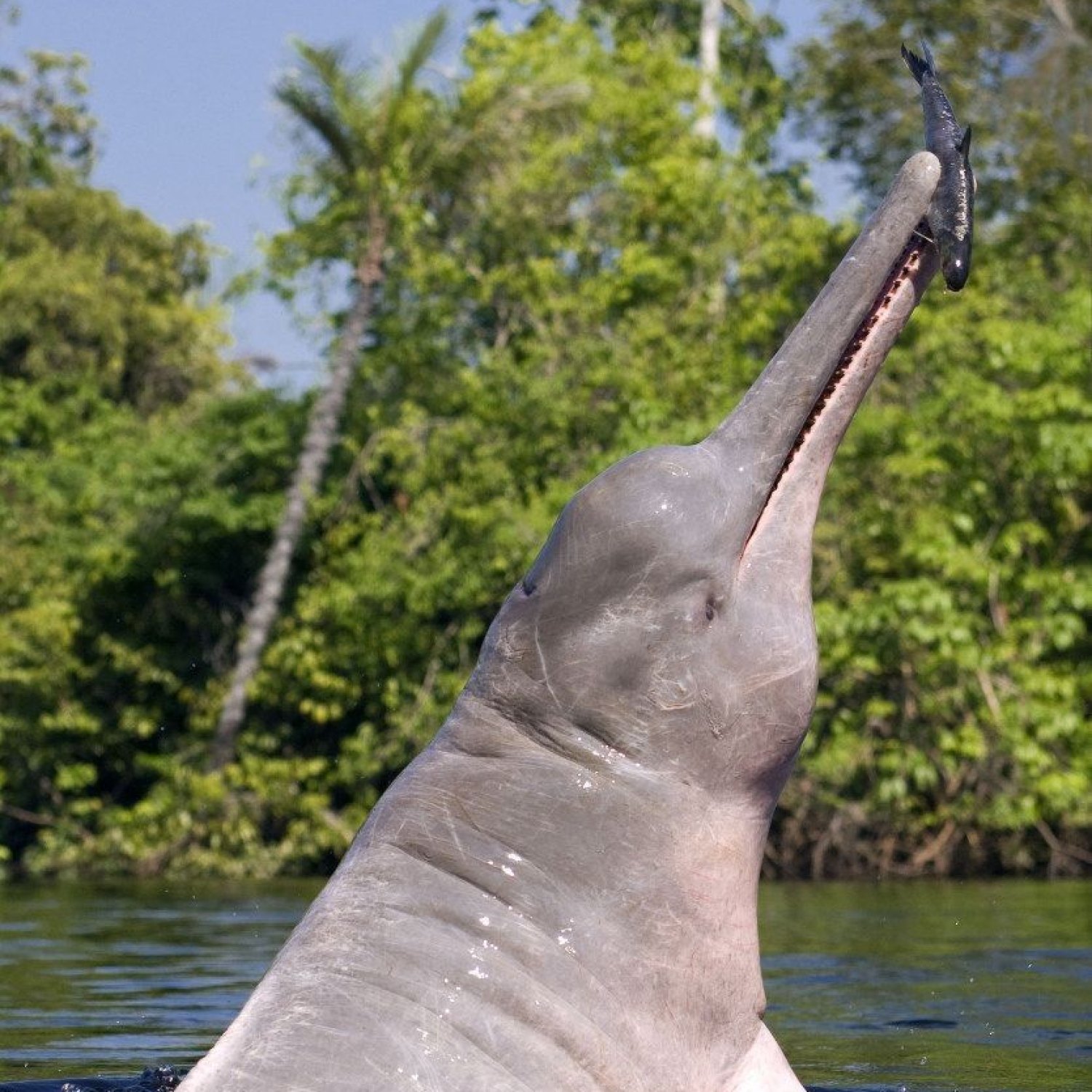
Amazon River Dolphin
6 to 8.5 feet (1.8 to 2.6 meters)
The Amazon River Dolphin, also known as the Pink Dolphin, is a unique freshwater mammal found in the Amazon River and its tributaries. With their slender body shape and long beak-like snout, they can reach lengths of 6 to 8.5 feet. As members of the Iniidae family, they are highly intelligent and social animals. Sadly, their population is declining due to threats such as pollution and habitat destruction. Let's work together to protect these beautiful creatures. #AmazonRiverDolphin #FreshwaterMammal #Conservation
Animal Details Summary:
Common Name: Amazon River Dolphin
Kingdom: Animalia
Habitat: Freshwater rivers and habitats in the Amazon rainforest
The Enchanting Amazon River Dolphin: A Unique and Mysterious Creature of the Amazon Rainforest
Deep in the heart of the Amazon rainforest, lurks a creature with a captivating pink hue, sleek and slender body, and a long beak-like snout. This is the Amazon River Dolphin, also known as the boto, pink river dolphin, or bufeo in South America. One of the most unique and mysterious creatures in the animal kingdom, the Amazon River Dolphin has fascinated humans for centuries with its unusual characteristics and behavior. In this article, we will explore the fascinating world of the Amazon River Dolphin and discover what makes it such a remarkable and enchanting creature Amazon River Dolphin.An Introduction to the Amazon River Dolphin
The Amazon River Dolphin, scientifically known as Inia geoffrensis, is a species of freshwater dolphin that inhabits the Amazon Basin in South America. It is the largest of the four species of river dolphins in the world and is the only one that is found exclusively in freshwater habitats. This beautiful mammal belongs to the Animalia kingdom, Chordata phylum, and Cetacea order, making it a distant relative of whales and other dolphins.Unlike its ocean-dwelling cousins, the Amazon River Dolphin is a master of living in freshwater rivers and habitats. It has adapted to its environment in a unique way, making it stand out from other dolphin species. Its body is slender and has a long and narrow beak-like snout, which is used for hunting and navigation in murky waters. The Amazon River Dolphin has small eyes and is known for its excellent sense of hearing, which helps it to navigate and communicate with other dolphins in the water.
The Stunning Beauty of the Amazon River Dolphin
The Amazon River Dolphin is a creature of rare beauty, with its signature grayish-pink to pink coloration. The pink color comes from its numerous capillaries, which lie just below its thin skin Arapaima. The deeper the dolphin dives, the more blood flows into these capillaries, making its skin appear even pinker. This phenomenon is known as "blushing" and is a unique evolutionary adaptation of this species.Another fascinating aspect of the Amazon River Dolphin's appearance is its body shape. It has a slender and elongated body, which makes it well-suited for swimming and maneuvering through the complex river systems of the Amazon rainforest. The long and narrow beak-like snout, which can measure up to one-third of its body length, helps the dolphin to navigate and hunt for food in the murky waters of the Amazon River.
The Feeding Habits of the Amazon River Dolphin
As a carnivorous species, the Amazon River Dolphin's diet mainly consists of fish, crabs, and crustaceans. However, due to its highly specialized habitat, this dolphin has developed unique feeding habits. Its long and narrow snout is equipped with over 100 sharp teeth, which it uses to trap and crush its prey. The dolphin also has a keen sense of echolocation, which helps it to track and locate prey in the dark and murky waters.What sets the Amazon River Dolphin apart from its ocean-dwelling cousins is its ability to swim on its side while hunting for food. This behavior, known as lateral feeding, allows the dolphin to better navigate and use its long snout to stir up the river bottom and flush out potential prey. It is a remarkable and fascinating hunting technique that has evolved over centuries, making the Amazon River Dolphin a highly efficient predator in its environment.
The Habitat of the Amazon River Dolphin: Exploring the Enchanting Amazon Rainforest
The Amazon River Dolphin is a highly adaptable species and can be found in various locations throughout the Amazon rainforest. Found exclusively in freshwater rivers and habitats, it has a vast geographical distribution, with a presence in multiple countries in South America. These include Brazil, Peru, Colombia, Ecuador, Venezuela, Bolivia, and Guyana.The Amazon River Dolphin primarily inhabits the Amazon River and its tributaries, making it an essential part of the river's ecosystem. It lives in groups, or pods, that consist of 2 to 8 individuals, led by a dominant male dolphin. The dolphin's strong social bonds and intelligence make it a cooperative and social animal, often seen playing and interacting with other members of its pod.
With its extraordinary adaptability, the Amazon River Dolphin has been able to survive and thrive in the diverse and ever-changing environment of the Amazon rainforest. However, due to various human activities such as pollution, dam constructions, and overfishing, the dolphin's habitat is under threat. It is crucial for us to protect and preserve these magnificent creatures and their habitat to ensure their survival for future generations.
The Conservation Efforts for the Amazon River Dolphin
The Amazon River Dolphin is listed as "Data Deficient" on the International Union for Conservation of Nature (IUCN) Red List. This means that there is not enough data on the species to determine its conservation status accurately. However, some populations of the dolphin are declining due to human activities such as poaching and dam constructions.One of the primary threats to the Amazon River Dolphin is entanglement in fishing gear. As the dolphin's habitat overlaps with fishing areas, it often gets trapped in fishing nets, which can lead to injury or death. Moreover, pollution from agricultural runoff and mining activities also poses a significant threat to the dolphin's survival, as it can affect the water quality and reduce the availability of food sources.
To address these threats and protect the Amazon River Dolphin, several conservation efforts are being undertaken in the Amazon rainforest. These include habitat restoration, awareness campaigns, and promoting sustainable fishing practices. Moreover, there have also been efforts to establish protected areas and implement stricter regulations on fishing in areas inhabited by the dolphin.
The Importance of NLP in Protecting Endangered Species
Natural Language Processing (NLP) is a branch of artificial intelligence that focuses on understanding and processing human language. It has many applications, including in the field of conservation and protecting endangered species.NLP can be useful in gathering and analyzing data on endangered species, such as the Amazon River Dolphin. By analyzing online content, social media posts, and other sources, NLP can provide insights into the current state of the dolphin's population and its habitat. This information can then be used to inform conservation efforts and address any emerging threats to the species.
Moreover, NLP can also help in detecting illegal activities, such as poaching, by monitoring online activity and identifying potential poaching hotspots. This technology can be used to alert authorities and take action before it's too late. By leveraging NLP, we can better understand and protect endangered species like the Amazon River Dolphin.
The Mysteries and Legends Surrounding the Amazon River Dolphin
The Amazon River Dolphin has been a source of fascination and wonder for centuries, not just for its unique characteristics but also because of the numerous myths and legends associated with it. In some cultures, the pink color of the dolphin's skin is believed to be a sign of good luck and protection from evil spirits. In other cultures, the dolphin is seen as a shape-shifter, able to take on human form and lure unsuspecting victims into the water.One of the most intriguing legends is that of the "Encantado," a shape-shifting dolphin who can transform into a handsome man and charm women in the villages. According to the legend, if a woman falls in love with an Encantado, she will follow him into the water and never be seen again. This legend has been passed down through generations and is still prevalent in some areas of the Amazon rainforest.
While these legends may seem far-fetched, they highlight the cultural significance of the Amazon River Dolphin in the lives of people living in the Amazon rainforest. It is a vital part of their culture and heritage, further emphasizing the need to protect and preserve this mysterious and enchanting creature.
In Conclusion
The Amazon River Dolphin is truly a one-of-a-kind creature, with its pink skin, long beak-like snout, and unique adaptations. It has captured the imagination of humans for centuries and continues to do so with its mysterious ways and legends surrounding it. As we continue to explore and learn more about the Amazon rainforest, it is vital that we also take steps to ensure the survival of this remarkable species and its habitat. The Amazon River Dolphin is a symbol of the beauty and diversity of the natural world and must be protected for generations to come.

Amazon River Dolphin
Animal Details Amazon River Dolphin - Scientific Name: Inia geoffrensis
- Category: Animals A
- Scientific Name: Inia geoffrensis
- Common Name: Amazon River Dolphin
- Kingdom: Animalia
- Phylum: Chordata
- Class: Mammalia
- Order: Cetacea
- Family: Iniidae
- Habitat: Freshwater rivers and habitats in the Amazon rainforest
- Feeding Method: Carnivore
- Geographical Distribution: Amazon Basin in South America
- Country of Origin: Brazil, Peru, Colombia, Ecuador, Venezuela, Bolivia, Guyana
- Location: Amazon River and its tributaries
- Animal Coloration: Grayish-pink to pink
- Body Shape: Slender with a long and narrow beak-like snout
- Length: 6 to 8.5 feet (1.8 to 2.6 meters)
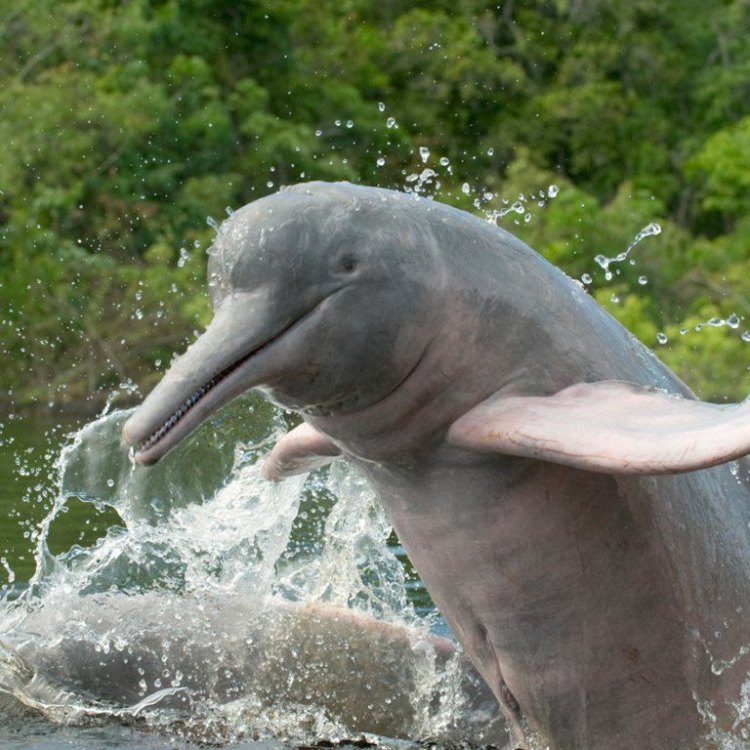
Amazon River Dolphin
- Adult Size: Large
- Average Lifespan: Up to 30 years
- Reproduction: Sexual
- Reproductive Behavior: Females give birth to a single calf every 2 to 4 years
- Sound or Call: Whistles, clicks, and bursts of ultrasonic sounds
- Migration Pattern: Partially migratory
- Social Groups: Live in small groups called pods
- Behavior: Active during the day and night
- Threats: Habitat loss, water pollution, fishing, and hunting
- Conservation Status: Vulnerable
- Impact on Ecosystem: Indicator species for the health of freshwater ecosystems
- Human Use: Tourism, folklore, and traditional medicines
- Distinctive Features: Long beak-like snout and a curved dorsal fin
- Interesting Facts: Amazon River dolphins can turn their heads 180 degrees
- Predator: No natural predators
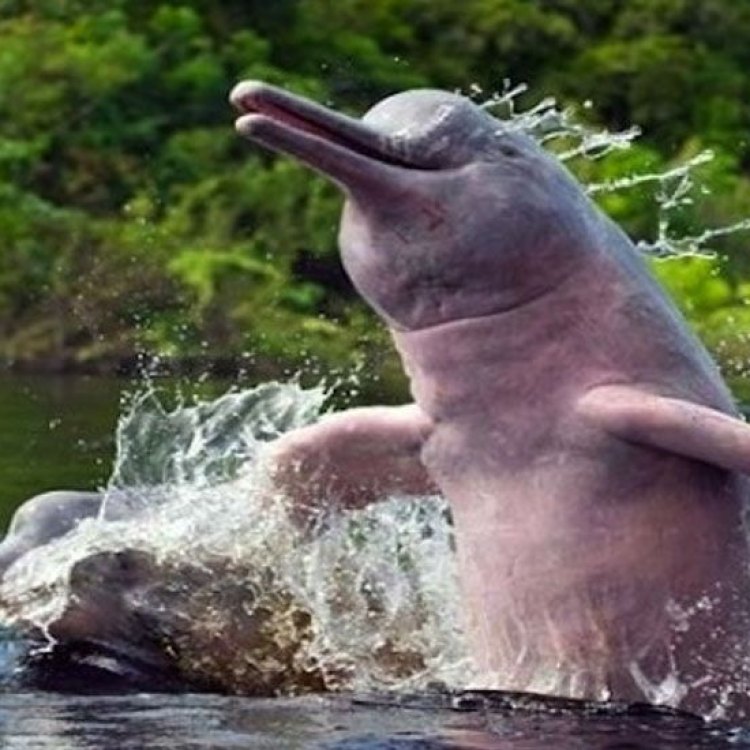
Inia geoffrensis
Discovering the Mysterious Amazon River Dolphin: A Fascinating Tale of Adaptation and Survival
The Amazon River, the largest river in the world, is home to a variety of unique and fascinating creatures. One such creature that has captured the attention of researchers and nature enthusiasts is the Amazon River Dolphin (Inia geoffrensis). Also known as 'boto' or 'pink river dolphin', this elusive species has remained an enigma to many, despite being present in the river for millions of years. In this article, we will dive deep into the world of Amazon River dolphins and explore their distinctive features, behavior, and role in the ecosystem PeaceOfAnimals.Com.Unique Features
The Amazon River dolphin is the largest species of river dolphin in the world, with adult males reaching lengths of up to 8 feet and weighing up to 400 pounds. It has a long and slender body, with a long, beak-like snout, and a curved dorsal fin that gives it a distinct appearance. Their colors vary from gray to pink, depending on age, gender, and water temperature. Interestingly, they also have a unique pinkish hue, which is a result of the blood vessels close to the surface of their skin.
But perhaps the most fascinating feature of these creatures is their adaptability and flexibility. Unlike their oceanic cousins, Amazon River dolphins have evolved to thrive in freshwater habitats. As such, they have several adaptations that allow them to navigate through the murky, vegetation-rich waters of the Amazon River. For instance, they have a flexible neck that enables them to turn their heads 180 degrees, allowing them to maneuver through the dense vegetation and catch their prey.
Behavior and Reproduction
Amazon River dolphins are highly intelligent and social creatures African Fish Eagle. They live in small groups called 'pods' that consist of up to 8 individuals, including one male, a few females, and their offspring. These pods are known to have a strong bond, with members sharing food and protecting each other from predators.
Being sexually reproductive, females give birth to a single calf every 2 to 4 years, with a gestation period of approximately 11 months. The calves are born in the water, and like all dolphins, they are born tail-first, so they do not drown. The calves stay close to their mothers for the first few years, learning essential skills for survival. However, despite being born in the water, newborn Amazon River dolphins hold their breath for only about 10 seconds, unlike adults who can hold their breath for up to 10 minutes.
Communication and Navigation
The Amazon River dolphins' communication is a sophisticated network of whistles, clicks, and bursts of ultrasonic sounds, which can be heard up to 16 feet away. These sounds are used to locate prey, navigate through the murky waters, and communicate with other dolphins. They also use echolocation, similar to bats, to navigate through their environment and locate food.
Habitat and Migration
Amazon River dolphins are found in the Amazon River basin, including the river's tributaries in Brazil, Bolivia, Peru, Ecuador, Colombia, and Venezuela. While they generally stay in one place, they can be partially migratory, moving to different parts of the river during the rainy season to find food and avoid predators. They are also known to migrate upstream towards the Andes during the dry season, where the water is clearer, making it easier to hunt.
Threats and Conservation Status
The Amazon River dolphin is classified as 'vulnerable' on the IUCN Red List of Threatened Species. Their population has drastically decreased over the years due to various human activities that have disrupted their habitat and food sources. These include habitat loss, water pollution, overfishing, and hunting.
The Amazon River dolphin is also considered an 'indicator species' for the health of freshwater ecosystems. This means that their presence or absence can indicate the overall health of the ecosystem. Therefore, their decline is not only a threat to their species but also to the entire ecosystem.
Human Use and Impact
Despite being a threatened species, Amazon River dolphins have long been significant to the Amazonian communities. The locals have incorporated these creatures into their folklore, often portraying them as mystical and magical creatures. They have also been a part of traditional medicines, with some believing that their fat has healing properties. In recent years, Amazon River dolphins have also become a popular attraction for tourists, who are eager to catch a glimpse of these elusive creatures in their natural habitat.
The Importance of Conservation
The threats faced by Amazon River dolphins are a cause for concern, not just for their species but the entire freshwater ecosystem. As an apex predator, the decline in their population can lead to an increase in their prey's population, which can have damaging effects on the ecosystem. Additionally, the Amazon River is a vital source of freshwater for millions of people, making the conservation of this dolphin species crucial.
Several conservation efforts are currently being implemented to protect the Amazon River dolphin, including creating protected areas, monitoring their population, and raising awareness about the species' importance in the ecosystem. However, more needs to be done to ensure their survival and the overall health of the Amazon River.
Conclusion
The Amazon River dolphin is a fascinating creature that has adapted and survived in one of the most challenging environments in the world. With their unique features, behavior, and role in the ecosystem, these elusive creatures have captured the hearts of many. However, their population is facing threats that require urgent attention and conservation efforts to protect them and the ecosystem they call home. It is our responsibility as humans to ensure the survival of this magnificent species for generations to come. So, let us do our part and spread awareness about the importance of protecting the Amazon River dolphin and its habitat.
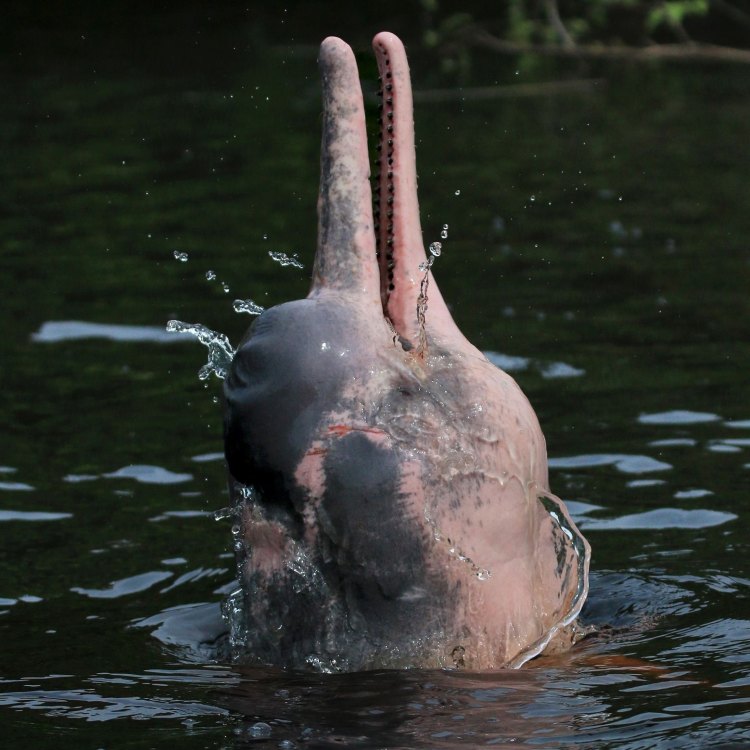
The Enchanting Amazon River Dolphin: A Unique and Mysterious Creature of the Amazon Rainforest
Disclaimer: The content provided is for informational purposes only. We cannot guarantee the accuracy of the information on this page 100%. All information provided here may change without prior notice.


